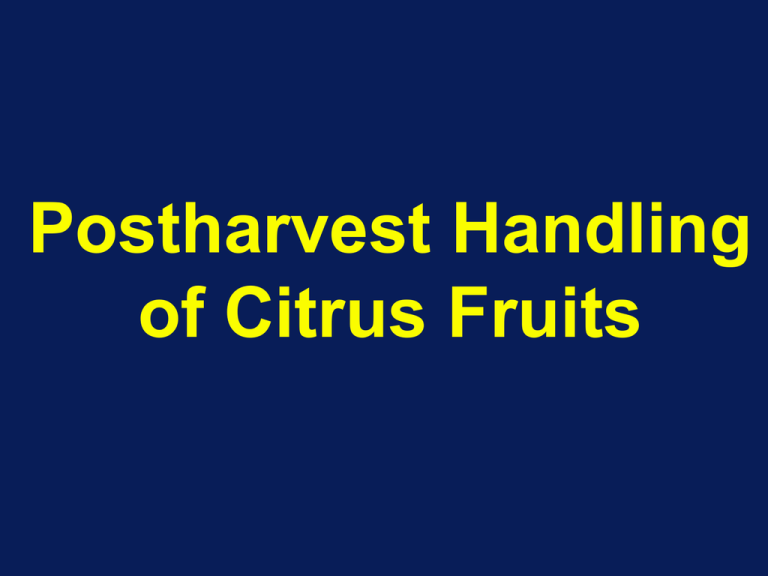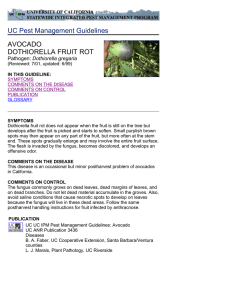Postharvest Handling of Citrus Fruits
advertisement

Postharvest Handling of Citrus Fruits Postharvest deterioration • • • • Harvested fruit are still living Continue to respire Loose water but not replaced The respiratory rate of the rind is nearly ten times as high as that of vesicles • Rind- plays a imp. physiological role in the qualitative changes in storage Postharvest deterioration • Respiratory rates are stimulated by dropping and bruising • GFT dropped in 1.2-1.8 M on to hard surface increase in respiratory rate and internal ethylene production. • Refer. Table 6 in Miller and Wagner 1991 paper. Postharvest Storage • Citrus fruits have relatively long postharevst life. • Loose skinned fruits- Satsuma mandarin and Ponkan easily puff at high humidity • Prestorage curing of the fruits also reduces decay and chilling injury during storage • Each variety has different optimum conditions for storage (Table 2.6) Postharvest Storage- Grapefruit • Store 6-10 weeks • Wax- with fungicide extends storage life and wax is also desirable to minimize moisture loss during transportation and storage. • Susceptible to chilling injury below 10C. Postharvest Storage- Lemons • Most lemons are ready to consume after harvest, but need conditioning to degreen. • Conditioning: 13-15.5c, 85-90% R.H. • Stored for 1-4 months • Temp: 11-14.4C • Individually sealed packaging with high density polyethylene (HDPE) film at 13C extends the storage life of “Eureka” lemons Postharvest Storage- oranges • Orange quality does not improve during storage • Stored at 2-7C for 8-12 weeks depending cultivar and production region • Pitting and chilling injury below 2-3C • High temp: blue mold and green mold • Individually sealed packing with LDPE film reduces fungal rots. Postharvest Storage- Satsuma mandarins • Storage life is longer • Fruit quality can be improved during storage by the reduction of acidity • Curing is necessary to avoid puffy fruit • A hot dip treatment (25 or 52C for 3 min) significantly reduces fungal decay. Controlled-atmosphere storage • Research has been done • Results are promising • Commercially not used because: – Economic reasons – Physiological characteristics of fruit – Elevated CO2 has no beneficial effect – Low O2 stimulates ethanol and acetaldehyde • Proposed CA conditions for Satsuma 8-12% O2, 0-2 % CO2 at 1-4 C, 83-90 RH Physiological Disorders • Influence quality in the markets • Causes: Pre- and post-harvest factors • Preharvest: B, and Cu deficiency, ammoniation, Zebra skin, fruitsplitting, creasing, sun burn, wind scar and freezing Zebra skin • Usually occurs in tangerines • Darkening of areas of the peel over the individual fruit segments • Drought stress followed by a sudden availability of soil moisture Zebra skin • Fruits absorb water and become turgid • Epidermal cells in the ridges over fruit segments are most exposed and likely to be damaged by harvesting, handling and packline brushes. Creasing • Results when crack develops in the albedo causing a crease in the overlaying flavedo • Most sweet oranges • Reasons: – K deficiency – High N – Temp during the period of maximum peel growth and development • Early harvest may solve the problem Fruit Splitting • Problem in Fall • Believed to be a problem of water relations and peel thickness • Trees take up water from rain or irrigation and fruit expands, bursting the peel in a crack across the bottom • K and Cu deficiency • Younger trees more problem than mature trees Sunburn • Damage leaves, stems and fruit. • Leaves: gum spots some times like melanose or greasy spot. • Fruit: shoulders of tree in the southwest quadrant. • Honey tangerine susceptible • Drying of exposed portions of the peel, pulp and the juice beneath it. • Damaged areas will have advanced color break. Wind Scaring • By abrasive contact with leaves, twigs, and thorns. • Injured areas grow with fruit-later become large. • Damage is cosmetic • Injury sites are invaded by microorganisms • Control: – Regular pruning – windbreaks Physiological Disorders • Postharvest factors: –Temp, humidity, gaseous composition, mechanical stress and aging • Disorders: Puffiness, pitting, chilling injury, granulation, oleocellosis, stem end break down, stylar-end break down, and freezing injury Postharvest Pitting • It is characterized by the emergence of clusters of collapsed oil glands that are scattered over the surface of fruits • The collapsed regions eventually become bronze and develop more predominantly near the blossom end. • White grapefruit, Fallglo tangerines, Temple and navel oranges Postharvest Pitting • Increases with fruit size • Not a phytotoxic burn but triggered by low oxygen within the fruit. –High respiration stimulated by high temp storage and low gas exchange rates caused by high shine waxes. Postharvest Pitting • Control: –Pulp temp should be 50F (10C) or less. –Reducing to 40F may increase CI –Waxing with coating that have relatively low shine, but high gas permeability has been shown reduce pitting Chilling Injury (CI) • Collapse is not targeted oil glands • A collapse of discrete areas of the peel from sunken darkened lesions which will slowly expand. • Very early and Very late harvested GRF. • Low RH enhance CI • Grapefruit- 4.4 C in FL • Waxing-Reduce but not eliminate CI • Thiobendazole (TBZ) or Imazalil Granulation • Fruit which is dry or ricey • Causes: –over maturity, sun burn, freezing, lack of water, excessive tree vigor, mite damage, cool, dry and windy conditions • Keeping trees well irrigated will avoid fruit from drying out. Oleocellosis (Oil spotting) • Navel oranges, lemons, and limes mostly affected. • Oil released from broken peel oil cells in the flavedo. • Oils are toxic to the surface of the peel and cause necrosis of the surface cells • Early morning-highest turgidity following the night when stomates are closed in the leaves and fruit Contd. Oleocellosis (Oil spotting) • Reduced by: –Avoid harvest until the fruit less turgid. –A pressure tester used to test turgidity –A pressure range of 0-10 lbs is adequate to detect tender peel to resistant peel to oil spotting. Stem-End Rind Breakdown • Most often in oranges and Temples. • Thin skinned fruit are more affected than thick skinned fruit. • Collapse of rind tissues resulting in sunken brown area which is irregular in shape. • Narrow ring of unaffected tissue immediately around the stem area which has no stomata. • N and K imbalance ? Contd. Stem-End Rind Breakdown • Moisture loss from fruit after harvest before waxing. • Control: –Reduce interval harvest and waxing –Hold fruits at high RH –Avoid excessive brushing on the packing line »Automatic packingline brush wipeouts will reduce time on brushes Stylar-End Breakdown (SEB) • Common in seedless limes • First appears as tan water-soaked areas on harvested fruit. • Pencillium is secondary infection • Occurs in Summer- confused with yellow tip • SEB- result of ruptured juice vesicles in the margins of mature, turgid, limes. • Caused by post harvest solar heating on fruits picked during periods of high turgor pressure. Contd. Stylar-End Breakdown (SEB) • The liberated juice invades the rind at stylar end • The acidic juice causes breakdown of chlorophyll in the flavedo. • Fruits with oil release pressure of 3.0 kg are safe. • Control: –Avoid harvest of large fruit –Pick late in morning –Careful handling Blossom-end clearing (BEC) • Late in the season on high quality thin skinned grapefruit. • Ruptured juice vesicles in the core of fruit. • Juice in the center cavity soaks through the peel. • Higher pulp temp and lower RH increase BEC • Control:harvest thin skinned earlier and precooling before handling Rumple of Lemons • • • • Lemon juice and oil-not affected Reported in Sicily as “wrinkle rind” FL- later summer as chlorotic rind spot Oil glands develop a greenish through tan and brown to black • May affect 75% of the in some years • Fully mature large fruit develop this disorder and high N • Control: Early harvest and reduce N. Plugging • Removal of portion of the rind when the fruit is pulled from the stem during harvest • Loose skinned mandarins is common • Careful harvesting • Clipping without protruding stems • Oranges, grapefruit and tight skinned mandarins- harvest by snapping Blue Albedo • Albedo,VB, segment walls and juice sacs have distinct blue color • Reported in 1944 associated with stubborn • Excessive fertilizer and high salt • Excessive rain and lack of drainage • Blue color is similar to anthocyanins • Control: Avoid excess fertilizer and provide better drainage Stylar-End Russetting • Not common • stippling or russetting of the stylar ends of the fruits • Blemish appear to be a linked series of very slightly raised corky lines in a netted pattern. • Navel orange • Confused with rust mite The Degreening Atmosphere • • • • • Ethylene Temperature Humidity Air Circulation Ventilation and Atmospheric Composition Ethylene • Results in the destruction of chlorophyll and the development of carotenoids • Will stimulate respiration; with low ethylene levels effect is transitory • May stimulate volatile production –Greater stimulation in green vs yellow fruits (Norman and Craft, 1968) Ethylene • May enhance decay especially stem end rots and anthracnose • Hastens button senescence • It is unnecessary to exceed 5 ppm, lower concentrations may be equally effective depending on cultivar Temperature • Degreening temperature varies with growing region –29C in FL & TX vs. 20-21C in CA –High temperatures inhibit carotenoid pigments (>30C) Humidity • Low R.H. may result: –soft fruit and loss of size –may accentuate physical blemishes and increase stem end rind breakdown • Very low humidity may degreening inhibit process • Best results with 90-95% Air Circulation • Good air circulation is needed – to equalize conditions of temperature, humidity, ethylene through entire room – to uniformly deliver ethylene to every fruit – to remove unwanted products such as carbon dioxide and volatiles (?) from room Atmospheric Composition • High carbon dioxide can inhibit ethylene • Threshold values of CO2 inhibitory effect is unclear – 1% - FL orange and grapefruit degreening rooms (Grierson and Newhall, 1960) – 2.5%, Shamouti oranges; 5%, lemons (Cohen, 1973) in controlled environment • Oxygen concentration may have some influence; reports are confusing Prior Factors Affecting Degreening • Fruit Maturity, Tree Vigor, and Climatic Effects • Cultural Practices • Packinghouse Treatments • Degreening Room Design Fruit Maturity, Tree Vigor, and Climatic Effects • Immature fruit may be poorly colored • Fruit from trees that are vigorously flushing are more difficult to degreen • Natural color break needs to have been initiated – 7 - 13 C night temperatures • For best color development in valencia orange need (Young and Erickson, 1961) – 20C day; 7C night; 12C soil Cultural Practices • Rootstock –Affects tree vigor and may therefore affect color break • Spray Programs –Summer oil insecticide sprays may delay color break –Gibberellin application contd. Cultural Practices • Fertilization Practices –High Nitrogen which increases tree vigor, thereby affecting color break Packinghouse Treatments • Bin Drenching • Washing –Increases time for degreening? • Waxing –Inhibits degreening • Color Sorting –Increases efficacy of treatment Postharvest Diseases Green Mold and Blue Mold • Green Mold - Pencillium digitatum Sacc. • Blue Mold - Pencillium italicum Wehmer. Fungus enters the fruit only through injury • Olive-green fungus spores- Green mold Bright blue spores • Later sporulating area is surrounded by a white margin (Wide for green than Blue) • Pencillium can become resistant fungicides Ship temp below 4.4C will delay mold dev. Sour rot (Geotrichum candidum) • Soil borne disease, spread by water and wind • Mandarins and mature oranges and Grft. • Mechanical wound or insect damage • water soaked areas, clear yellow lesions • Infection spreads to soft decaying area at 27C • Sour odor with decay and attracts fruit flies • Spread the healthy fruit in packed cartons Sour rot (Geotrichum candidum) • Control: –limiting soil contact with fruit –limiting injuries –Delay harvest until normal turgidity –Sanitation with chlorine –Hold fruits below 10C Stem-End Rot • • • • Phomopsis citri Faw. and Diplodia natalensis Pole-Evans Most destructive fruit decay in FL Fungi colonize dead twigs and wood on the tree and dispersed by rain and wind to fruit. • Diplodia - found in the core, stylar end • Phomopsis- spreads through core and even rind pattern from the stem end without finger-like projections Stem-End Rot • It does not spread from fruit to fruit in packed cartons • After harvest fungus grows from calyx into the fruit • Diplodia - early season • Phomopsis- late season • Cultural practices to remove dead wood • Harvesting by snapping • Ethyelene level should be optimum Quarantine Treatments • Citrus is a host for many fruit fly species • A number of our markets have insect quarantine regulations regarding the importation of fruit from infested areas Quarantine Treatments • Currently approved quarantine treatments: – Cold treatment – Methyl Bromide Fumigation – Vapor Heat • High-temperature forced-air (HTFA) – Modification of vapor heat – Approved for papayas (HI, Belize, Chile), Mex grapefruit and Mex mangos HTFA Treatments • Ramped : 35 to 48.5C • Stepped: 40C for 120 min, 45C for 90 min, 48.5C • Constant: 46C for 230 min



